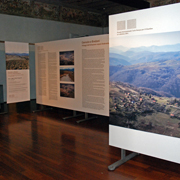
Osmače e Brežani
documentary and photographic exhibition on the Prize-winning site
| - |
|---|
The aim of the exhibition dedicated to the 25th edition of the International Carlo Scarpa Garden Prize is to offer the essential elements to follow the historical-political events, the geographic features and life conditions of the awarded site, consisting of two villages, Osmace and Brežani, on the plateau overlooking Srebrenica in Bosnia Herzegovina.
The set-up of the exhibition, arranged in four sections, includes photography documents and audiovisuals as well as a collection of bibliographic materials which can be consulted in a special room.
The first section illustrates the geographic and historical features of the site, being set in the Bosnia region and with its links to a wider geographical horizon as that of Balkan Europe. The essential data crucial to understanding the long historical-political events that marked this part of Europe is given, including the tragic events involving Srebrenica and its region during the 1991-1995 war.
The second section describes the distinctive features, life and landscape of the two villages and surrounding area. It illustrates the layout of the hamlets, the topography coordinates of the farmed fields, pastures, kitchen gardens and houses, the road network and buildings for social and religious life.
This section also includes a painting by the Bosnian painter Safet Zec, on the theme of villages in this land.
The third section covers the various activities, supported by fringe initiatives, to start farming new crops in this area — namely buckwheat and berries — involving a group of young families who returned to their land after a long time of forced exile and neglect.
The fourth section of the exhibition presents some documents emerging from the many testimonies and experiences to do with the wide gamut of activities supporting the rebirth of and return to this place, specifically — with the Adopt Srebrenica project — the Alexander Langer Foundation and the Tuzlanska Amica association.
Some fragments of video documents show scenes of village life prior to 1992; a video document produced by Centro Pace of Venice in 2012 and the one produced during the study trip of Fondazione Benetton Studi Ricerche (February-March 2014), filmed by Ziyah Gafic and Jasmin Brutus, show some testimonies of members of the small group of families that survived the war and rediscovered their bond with their homes, the farm land, the memory of an inhabited place.
The exhibition — which was designed by Luigi Latini — builds from the themes and illustrated iconographic material of the Osmače and Brežani dossier. International Carlo Scarpa Garden Prize, curated by Domenico Luciani and Patrizia Boschiero, with Andrea Rizza Goldstein, published by Fondazione Benetton.
